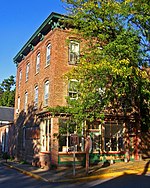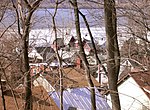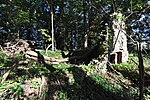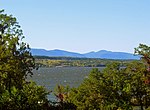Rhinecliff station
Amtrak stations in New York (state)Buildings and structures in Rhinebeck, New YorkFormer Central New England Railway stationsFormer New York Central Railroad stationsHistoric district contributing properties in New York (state) ... and 5 more
National Register of Historic Places in Dutchess County, New YorkRailway stations in Dutchess County, New YorkRailway stations in the United States opened in 1914Railway stations on the National Register of Historic Places in New York (state)Use mdy dates from August 2023

Rhinecliff station (formerly Rhinecliff–Kingston) is an Amtrak intercity rail station located in the Rhinecliff hamlet of Rhinebeck, New York, United States. The station has one low-level island platform, with a wheelchair lift for accessibility. It is served by the Adirondack, Berkshire Flyer, Empire Service, Ethan Allen Express, and Maple Leaf.
Excerpt from the Wikipedia article Rhinecliff station (License: CC BY-SA 3.0, Authors, Images).Rhinecliff station
Rhinecliff Road,
Geographical coordinates (GPS) Address External links Nearby Places Show on map
Geographical coordinates (GPS)
| Latitude | Longitude |
|---|---|
| N 41.921277 ° | E -73.951379 ° |
Address
Rhinecliff-Kingston
Rhinecliff Road 455
12574
New York, United States
Open on Google Maps










